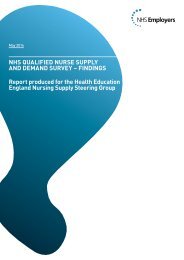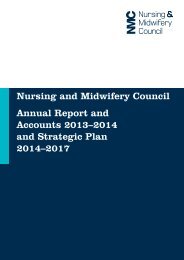Journal_1_2014_final_WEB
Journal_1_2014_final_WEB
Journal_1_2014_final_WEB
Create successful ePaper yourself
Turn your PDF publications into a flip-book with our unique Google optimized e-Paper software.
Science, Practice and Education<br />
Prevalence of Pressure Ulcers<br />
in Hospitalized Patients<br />
in Germany – Trends from 2005 to 2011<br />
Summary<br />
Objective: Based on the data of hospitalized people<br />
in Germany we aimed to determine changes<br />
in prevalence, localization of pressure ulcer (PU)<br />
and comorbidity of the affected patients in the<br />
period from 2005 to 2011.<br />
Patients and Methods: Age-adjusted prevalence<br />
and tables for gender and age distribution of pressure<br />
ulcers separately for the principal diagnosis<br />
and for additional diagnoses were provided from<br />
the Federal Statistical Office. Hospitals are legally<br />
obliged to deliver extensive data on hospital treatment,<br />
including demographic data, diagnoses, comorbidities,<br />
complications, and procedures to the<br />
“Institute for the Hospital Remuneration System”<br />
which uses the data for yearly adaptation of the<br />
German Diagnosis Related Group System.<br />
Results: Total number of cases hospitalized with<br />
the principal diagnosis PU increased from 9,941<br />
in 2005 to 12,581 in 2011 (increase of 26.5 %)<br />
with a disproportional increase of PU grade<br />
4 (from 46 % in 2005 to 59 % in 2001). Total<br />
number of cases hospitalized having the additional<br />
diagnosis PU increased from 239,760 in 2005 to<br />
412,029 in 2011 (increase of 71.8 %) with a disproportional<br />
of PU grade 2 (from 39 % to 47 %).<br />
Age adjusted population based data per 100,000<br />
inhabitants show no increase in cases with the<br />
principal diagnosis, but cases with the additional<br />
diagnosis does. Comparing the distribution of<br />
PU localisation there are no relevant differences<br />
between 2005 and 2011 with the exception of<br />
a decrease of PUs of rare localisation (head, upper<br />
extremity, vertebral spin) and not specified<br />
localizations (principal diagnosis: from 25.8 % to<br />
16.5 %, additional diagnosis from 29.1 % 18.0 %).<br />
Patterns of comorbidity did not change in the<br />
period from 2005 to 2011. Urinary and faecal<br />
incontinence play a major role in those with the<br />
principal diagnosis PU whereas fracture of femur,<br />
heart failure and pneumonia are the most frequent<br />
diagnoses coded with the additional diagnosis of<br />
PU.<br />
Conclusion: In Germany the rate of cases hospitalized<br />
with the principal diagnosis PU did not<br />
increase whereas the rate of PU documented in<br />
hospitalized patients increased from 2005 to 2011.<br />
Heidi Heinhold 1<br />
<strong>Journal</strong>ist<br />
Andreas Westerfellhaus 2<br />
Introduction<br />
Pressure ulcer is a generally preventable complication<br />
of immobility 1,2,3,4 . The awareness for<br />
prevention of pressure ulcers (PU) and for early<br />
detection increased in the last decades 5,6 . The<br />
impact of these changes in awareness and in prevention<br />
on the prevalence of PU is unclear. Data<br />
from the National Center for Health Statistics<br />
and the Washington State Department of Health<br />
for the 14-year period from 1987 through 2000<br />
found no evidence that the guidelines for the prevention<br />
of PU have been effective in decreasing<br />
pressure ulcer formation in the United States 4 .<br />
As a limitation of their findings they stated that<br />
they could not exclude a more thorough man-<br />
ner of reporting pressure ulcer counteracting a<br />
decrease in the absolute number of PU. It could<br />
also be accounted for by changing demongraphics<br />
in that, the incidence of chronic disease is increasing<br />
along with increased age profile and thus one<br />
would expect a similar increase in PU, but this did<br />
not happen. So the guidelines might be effective<br />
in decreasing PU in absolute terms. The same is<br />
reported for Canada in a more recent study based<br />
on the Annual Pressure Ulcer Prevalence Census<br />
1994-2008 7 . In contrast to the somewhat constant<br />
prevalence and incidence of PE in these countries,<br />
an analysis of seven cross-sectional studies<br />
reporting point PU prevalence in 225 German<br />
<br />
Knut Kröger 3<br />
1 for the Deutsche<br />
Dekubitus Liga e.V.,<br />
2 for the Deutsche<br />
Pflegerat e.V.,<br />
3 for the Initiative<br />
Chronische Wunde e.V.,<br />
Correspondence:<br />
knut.kroeger@<br />
helios-kliniken.de<br />
Conflict of interest: none<br />
EWMA <strong>Journal</strong> <strong>2014</strong> vol 14 no 1 9




